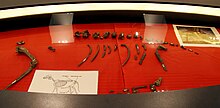Lycaon sekowei
| Lycaon sekowei Temporal range: Pliocene–Pleistocene
| |
|---|---|

| |
| Fossil of Lycaon sekowei, a possible ancestor of the African wild dog | |
| Scientific classification | |
| Domain: | Eukaryota |
| Kingdom: | Animalia |
| Phylum: | Chordata |
| Class: | Mammalia |
| Order: | Carnivora |
| Family: | Canidae |
| Genus: | Lycaon |
| Species: | †L. sekowei
|
| Binomial name | |
| †Lycaon sekowei Hartstone-Rose et al., 2010
| |
Lycaon sekowei is an extinct canid species from southern Africa that lived during the Pliocene and Pleistocene epochs.[1] Like L. pictus, the other species in the genus that is alive today, L. sekowei was a hypercarnivore; however, its front paws were not as specialized for running.[1]
References
- ^ a b Hartstone-Rose, A.; Werdelin, L.; De Ruiter, D. J.; Berger, L. R.; Churchill, S. E. (2010). "The Plio-Pleistocene Ancestor of Wild Dogs, Lycaon sekowei n. sp". Journal of Paleontology. 84 (2): 299–308. doi:10.1666/09-124.1.
Wikispecies has information related to Lycaon sekowei.
Wikimedia Commons has media related to Lycaon sekowei.
